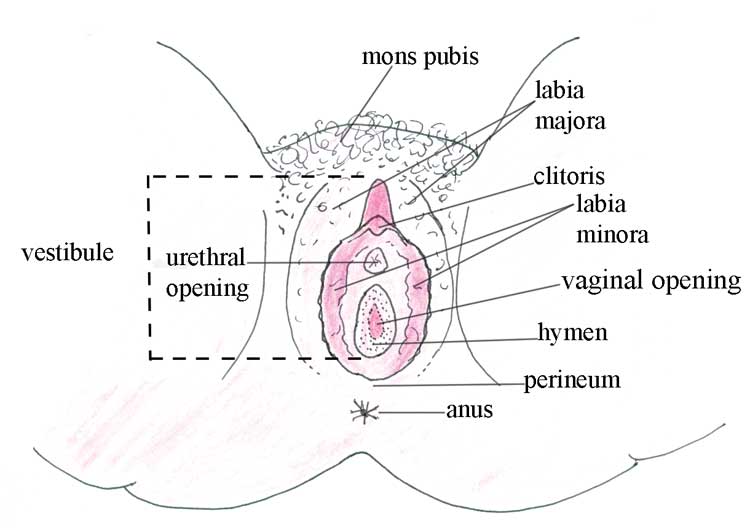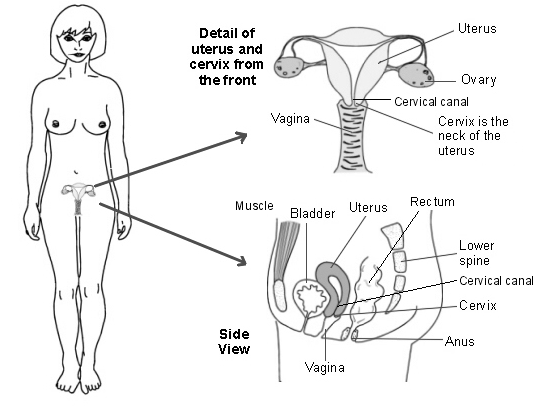Wombs Of Lilith
Puberty and Menarche
From Little Girl to Ready Maiden - Your Active Fertility Journey Begins

PUBERTY: THE BEGINNING OF YOUR ACTIVE FERTILITY JOURNEY
Your fertility journey began before you were even born. While still in your mothers' womb, your ovaries and the immature eggs within them formed. You were born with all of the eggs that you will ever have. They will remain dormant, waiting for the time when the active part of your fertility journey begins and you become a ready maiden. When this happens there will be many changes. both inside your body and on the surface.
The first sign that the active part of your fertility journey is starting is usually when your breasts begin to grow. This is called "Thelarche". It's stage 2 of the 5 Tanner Stages shown below. This could happen anywhere from age 8 to about 14. You will first find a little, firm bump behind one or both of your nipples, since they don't always grow at the same rate. This may be tender to the touch. Your areola (the colored area around your nipple) and the nipple itself will grow out from your chest, and your breasts will begin to grow out from your chest and and also start to get wider. Your nipple and areola will also widen along with your new breasts, and may also grow darker than before.

They will usually reach their full non-pregnant size in 3 to 5 years. When you become pregnant, they will grow even more. Keep in mind that breast size does not affect the ability to get pregnant or lactate or breastfeed. The only advantage that larger breasts may offer is that they can store more milk before becoming engorged or full.
Do not think that you must have large breasts to be considered attractive or pretty. That is not true. As long as your breasts are natural, even if "flat", they are beautiful.
Do not worry about comparing yourself to other girls. Breasts, nipples, and areolas come in all sizes and shapes and nipples and areolas can be very light, very dark, and all shades in between.
Some girls will get large areolas early on, and sometimes other girls will make fun of this. What they don't realize is that babies can't see very well when they are first born. A large, dark areola is a perfect target for them to latch on to when feeding. Some girls bodies prepare for this early on and it is not a problem or something to make fun of, but instead it is something to be welcomed and admired.
The American Cancer Society even recommends that every girl practice breast massage from the time they first begin to bud. It will promote good health by allowing you to immediately detect any changes in your breasts, and it will help you prepare for eventual lactation and breastfeeding.
Sometime after your breasts begin to grow, you will start to get some hair on your pubic area between your legs, and under your arms. In your pubic area, it will usually start as a few very fine, straight, soft hairs above your labia majora on your mons pubis in a fan shape. Over time there will be more that will cover your labia majora and even your inner thighs, and it will get darker and more curly.
About 1 in 10 girls will start to get their pubic hair before their breasts begin to grow. Sometimes they will get all of it before their breasts ever start growing, while others will get just a little before their breasts start growing.
Most girls elect to shave off the hair under their arms. Many girls elect to shave off their pubic hair, while others shave varying portions of it, and some let it grow out. It is your choice, there is no wrong answer.
Your hips will also start to get wider to facilitate vaginal childbirth.


On the inside, your reproductive parts are preparing to turn on so that you will be able to get pregnant and give birth to babies. Your ovaries are preparing to mature and release one of the eggs in them every month, and your uterus is preparing to grow a lining that will allow it to nurture a baby growing inside you.

During this time of puberty you may begin to think more about romantic things, think about possible motherhood, and you may even start to masturbate - or masturbate more frequently than you have in the past. This is normal and is nothing to be embarrassed about. This is a time of discovery and learning. Learning how your body works and how it reacts to pleasure is an important part of this journey.
MENARCHE : READY FOR POTENTIAL MOTHERHOOD
Sometime about 2 to 2 1/2 years after your breasts first begin to grow you will have your first menstrual cycle. This is called "Menarche" and is something to be celebrated. It means that you are finally able to conceive (get pregnant), carry, and give birth to babies. You will actually ovulate (release a mature egg from one of your ovaries) before your first period and it is possible that you can get pregnant just before having your first period if you are already sexually active.
If you don't get pregnant, the lining that grew in your uterus during the previous month isn't needed. Your body releases it, and the blood and tissue come out of your vagina. This is called menstruation or a "period" or "monthly". The lining doesn't come out all at once. It takes a few days for all of it to come out. Some days the "flow" of blood will be heavier than others. You will need to use either tampons or pads to capture the blood. These should be changed frequently until your period ends. You can try both to see which works best for you.
When your period ends, a new lining will grow in your uterus over the next month to prepare to nurture a baby inside you if you get pregnant. When the lining is ready, you will then ovulate. If you don't get pregnant after ovulating, the cycle will repeat. If you do get pregnant, you mostly likely miss your period, although you might have a little bleeding.
Some girls get very embarrassed when they get their period. This is nothing to be embarrassed about. You should be proud of what your body can now do. In many witchcraft traditions there are special ways to celebrate both Thelarche and Menarche. We will discuss some of those on our rituals page, and we recommend that this be celebrated by your entire family.
Very often, your first menstrual cycles will be irregular. This is common and is nothing to worry about. Sometimes girls have their first period and then don't have another for as long as 6 months. They usually become regular within the first year or two. Keeping track of them in a Reproductive Health Journal will help you track your fertility cycle for when you decide to conceive.